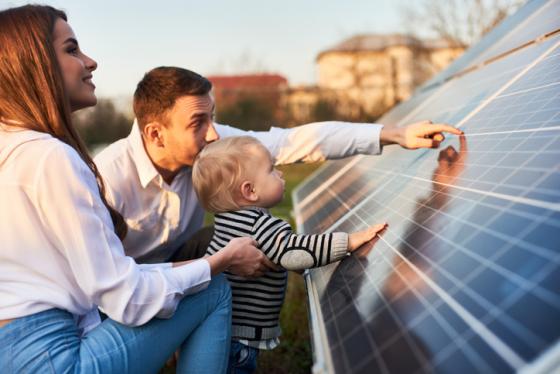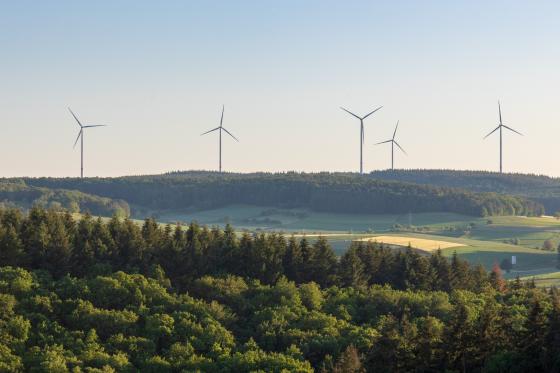About the Green Deal
About the Green Deal
What is it about?

The European Green Deal is Europe's growth strategy to make its economy more sustainable.
This ambitious Green Deal strategy aims to make Europe “climate neutral" by 2050. This means “net-zero" emissions.
Energy accounts for more than 75% of the EU's greenhouse gas (GHG) emissions. Decarbonising the energy sector forms the backbone of the Green Deal and ACER's work is highly relevant.
The Green Deal sees as key parts of the decarbonisation solution:
-
A massive increase in renewables (i.e. sustainable electricity)
-
Increased electrification (i.e. using sustainable electricity to then decarbonise other sectors such as transport and heating)
-
Sustainable or low-carbon hydrogen (for “hard to decarbonise" sectors)
The Green Deal introduces concepts which until recently were not part of most policymakers' vocabulary: e.g. Climate Neutrality, Power-to-Gas, Energy System Integration, Sustainable Taxonomy.
Check out ACER's Green Deal Glossary.
About the Green Deal
How does ACER’s mandate on energy link to Europe’s climate policy objectives?

ACER, as an EU Agency, significantly contributes in two main ways to Europe's Green Deal objective and the broader energy and decarbonisation objectives set at political level:
-
delivering on our core regulatory mandate which are rooted to Europe's (2019) Clean Energy laws.
-
providing advice and expertise to Europe's co-legislators on key Green Deal energy files. See also the ACER-CEER Green Deal Regulatory White Papers.
Article 1 of the ACER Regulation in referring to the establishment and objectives of ACER explains that ACER contributes “to the consistent, efficient and effective application of Union law in order to achieve the Union's climate and energy goals".
The Agency (and national energy regulators) play a pivotal role paving the way to decarbonise the economy at least cost to consumers by facilitating:
-
the massive increase in renewables that is needed (about 3 times the current renewable capacity base) to decarbonise the power sector
-
increased electrification of sectors (e.g. heating and transport) previously powered by fossil fuels (e.g. the regulatory treatment of EV charging stations)
-
the growth of a competitive renewable/low-carbon hydrogen market for energy-intensive or “hard to abate" emissions sectors (like aviation or chemicals)
-
more “flexibility" in the energy system (e.g. storage and Electric Vehicles (EV)) to enable a big shift to renewables. Put simply, more wind and solar is not enough. Storage (e.g. batteries, hydrogen storage) and adapting consumption are two examples of flexibility that is needed to plug the gaps when there is too much/little sun and wind.
-
empowering consumers (enabled through technology) to actively contribute to the transition (transforming how we use and generate energy, how we move around, and heat our homes) through smart homes, microgeneration and EV charging stations. The Agency's mandate was extended under the Clean Energy legislation to monitor compliance with the new consumer rights as well as monitoring electricity and gas wholesale and retail markets.
Alongside decarbonisation, ACER must also ensure that the European energy market is fully integrated, interconnected and digitalised to maintain security of supply. With energy identified as a critical sector in terms of cyber security, ACER plays a key role in electricity cybersecurity resilience and thus contributes to the wider EU cybersecurity strategy.
Europe's decarbonisation objective cuts across ACER work.
ACER pushes low-carbon solutions through market design and well-regulated markets and networks.
About the Green Deal
How does ACER contribute to the European Green Deal?
Energy and climate are linked. Energy accounts for > 75% of Europe's Greenhouse Gas (GHG) emissions. The framework in Europe has evolved. Europe has a 2020 climate and energy framework, a 2030 climate and energy framework, and now a 2050 climate neutrality objective.
Europe's (2019) Clean Energy laws facilitate the “clean energy transition" away from fossils towards a more sustainable energy. A core focus of ACER's work is implementation of the Clean Energy laws. ACER, an EU Agency, contributes from a regulatory perspective, to the implementation of the European Union's Green Deal and the broader energy and decarbonisation objectives set at political level.
ACER drives the decarbonisation of the energy sector by:
- Developing, implementing and monitoring the Network Codes – the binding EU-wide rules governing the electricity and gas sector. Why? Completing a well-functioning “Internal Electricity Market" is key for sustainable, reliable and affordable energy.
- Ensuring the electricity market rules and design (originally not intended for large amounts of renewables) are “fit for purpose" to integrate the massive expansion in renewables. In particular:
- ACER is reviewing the functioning of the real-time (intraday and balancing) electricity markets, to improve market access to renewables and help improve forecast accuracy and reduces balancing needs.
- Ensuring the electricity market design foster all sources of flexibility (e.g. flexible storage, aggregators).
- Integrating national energy markets into a single European-wide market. An integrated electricity market allows electricity to move freely across borders and delivers benefits to generators (bigger market), operators (reducing the costs of balancing, reserves and system operation) and citizens (who have access to competitive markets and secure supply).
- Monitoring how markets are functioning and how national network tariffs can be structured to better suit the energy transition (e.g. incentivising grid companies to find the cheapest sources of flexibility and consumers to align their energy use with flexibility needs).
- Building cost-efficient infrastructure (e.g. to bring cheap offshore wind to consumers) based on robust regulatory scrutiny (and not building at any cost).
- Maximising the interconnection capacity made available to the market for trading so consumers can chose from the cheapest and lowest emitting power available across Europe.
- Cooperation and dialogue among relevant stakeholders e.g. to deliver on the envisaged level of off-shore wind requires cooperation among Member States, project developers, network operators etc.
